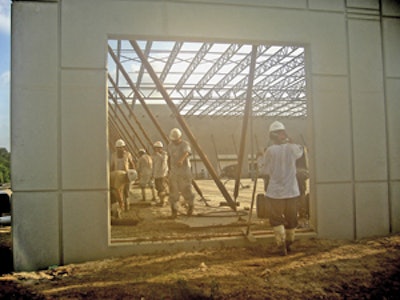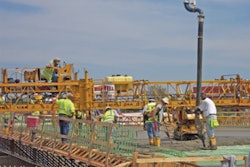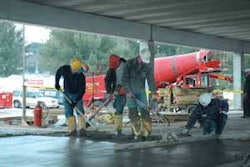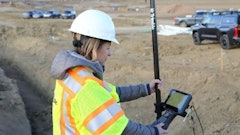
The melting pot that is America finds people from different cultures working together, particularly on construction sites.
While early immigrants were usually from Italy, Ireland, Poland and other European countries, today's non-native workers are most likely to come from Mexico and other Hispanic countries. Concrete contractors are faced with the challenge of blending the best of the traditional American work ethic with the work practices of these newer arrivals.
Communication issues
It might seem that speaking different languages would be the main source of communication difficulties on the job. But consultant Chris Krueger of Zerah Services Inc. attributes only 30 percent of misunderstandings to language, with 70 percent caused by cultural differences. He blames power distances for many miscommunications between workers and supervisors. "That has to do with how you interact with your boss," he explains. "If you're born in the U.S., you're expected to speak up and state your opinion if you have one. That will never happen in a meeting with workers from Mexico, Central and South America.
If the boss says, 'Did you understand?', they're going to shake their head 'yes' even if they don't. We call it 'Why does yes mean no?' It's really a cultural issue — you don't contradict the boss. You (the supervisor) need to observe to see if what you said is taking place (on the job) to be sure they understand or look to see if the light's on in their eyes."
Making sure workers understand is an important part of the supervisor's job, says Trademark Concrete Systems, Inc. General Superintendent Art Rodriguez.
"The fear of being reprimanded or called dumb will give (Hispanic) workers a tendency to say 'yes, yes, yes' when in actuality they only understand 50 percent of what was said," he says. "The foreman might catch them doing something they were told not to and will work with them on a one to one basis to correct it."
By having only bilingual field superintendents, Trademark Concrete has reduced language problems on its jobsites. What they have unexpectedly encountered is resistance to learning English from some Spanish speaking employees. Even though the company has offered free home tutoring and made clear that higher paid promotions to supervisor are only possible for English speakers, many employees who agree to take the classes don't follow through.
"I think they know that because they're working for a company that can understand what they're saying, they don't take (learning English) that seriously," notes Rodriguez. "Their mind is still back where they came from. If they worked in another state where there were fewer Hispanic businesses, they might feel there was no way out of this thing."
Safety considerations
Occupational Safety and Health Administration statistics show that a non-English speaking person is five times more likely to suffer an on-the-job accident than someone born in the United States, Krueger notes. That is the case even when companies have spent many thousands of dollars translating safety materials into Spanish. Since many workers from other countries have only six years of formal education, written safety information is unlikely to be read and even less likely to be understood. To compensate, supervisors "have to spend more time showing and telling in the job site environment," he says.
Structural Group recognized the need for Spanish language safety training in the late 1980s when they realized that in some geographic areas, 60 percent of their employees could not understand the weekly safety meetings, which were then held only in English. "Working effectively and safely in highly hazardous environments, such as confined spaces, chemical plants, high rise buildings, bridges or elevated structures, becomes very challenging when employees cannot fully understand the language," Safety Director Jim Emmons says. "We need employees to do the work but Structural Group cannot put employees into a situation where they do not understand how to work in a safe manner.
"We found that we needed to communicate things twice, once in Spanish and once in English," he continues. "We have developed a series of tools and resources in both languages that serve as aids in safety education and awareness. Our daily 'Job Safety Analysis' and weekly safety meetings are completed by our employees in two languages or in groups that use bilingual employees to help guide and mentor the employees." The company's safety manual has been translated into Spanish and both English and Spanish versions are available on all jobsites for use as both a reference and a communication tool. Structural Group also has training videos in both languages.
"Following up by observations helps to ensure that our employees understand the information they are given and are actively demonstrating safe work behaviors," Emmons notes.
Differing work attitudes
Where cross-cultural differences are most pronounced is in the differing attitudes toward work. "The ideology of what constitutes respect is very different in South America, Central America and Mexico," notes Seretta Construction vice president Andrew McPherson. "Respect is much more of a requirement for the Hispanic worker than the American worker. Regardless of how much you pay a Hispanic worker, if they feel as though you don't respect them as individuals and respect the work they do, they will not stay with you for the most part. American workers only care about money."
Unlike the movie image of the lazy, shiftless Mexican, construction companies find that Hispanic employees are dedicated workers. "The Hispanic worker, for the most part, is much harder working, has much more pride in the final product, is much more 'company' oriented and complains much less," McPherson says. "The American worker, for the most part, feels like everything is 'not his' or beneath him. The American worker has a sense of entitlement to him that workers from other countries don't have. The work ethic that made this country what it is today is being lost. No one wants to get dirty anymore."
Krueger agrees that Mexican workers have a strong work ethic, but sees them as more committed to their workgroup or team than to the organization. These workers are more likely to turnover, which is expensive for employers. "So if you're a business owner, you want to see if you can make your organizational culture attractive to the Mexican teamwork," he says. "That is not an easy thing, but the benefits are very significant for those who can. You do that by starting at the top." He suggests looking first at the company's organizational strengths and then trying to leverage them into being the employer of choice for people of culture. "In Latin culture, one of their great virtues is strong loyalty, much more so than American culture," he points out.
Though some employers fear that money spent training new employees will be wasted because they will leave, he says Latino employees will see this as personal and value it, so they will be more likely to stay with a company that invests in them.
Accepting the reality that non-native workers are different and dealing with it is crucial. "We encourage our employees to avoid stereotypes and develop and maintain a good understanding of their fellow employees and their culture," Emmons says. "We require our supervisors to take sensitivity training which gives our expectations for ethnic diversity. When people respect and value differences, they can become closer to each other which translates into a safer, more productive job site."
Blending the cultures
Getting the job done ultimately overrides any cultural differences when working with a multi-cultural crew. "American workers are a little leery at first to work with Hispanics because they are afraid of the language barrier," McPherson says. "The Hispanic worker is, many times, hesitant to work with the American worker because of past bad experiences of unfair treatment. Once a common work ethic is shared and demonstrated, there are no problems." Any interaction problems that don't ultimately work themselves out at the company are resolved by Seretta keeping the most productive workers and dismissing the others.
"Workers from other countries are here to work," McPherson says. "These workers do not feel that their children need Air Jordan tennis shoes or that two to three cars per family is mandatory or that they should have cable TV in every room of the house. The perception that these people are 'taking American jobs' is nonsense. These jobs are ready to be filled by Americans at any time. The bottom line is that Americans don't want them. It is not that these workers are being paid less or that benefits are not being provided. That is the furthest thing from the truth."
Jean Feingold is a Gainesville, Fla.-based writer who frequently covers concrete and other construction-related topics.


















